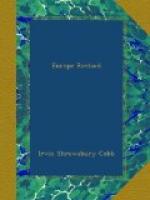It is true that, in lieu of the fresh fruit an American prefers, the waiter brings at least three kinds of particularly sticky marmalade and, in accordance with a custom that dates back to the time of the Druids, spangles the breakfast cloth over with a large number of empty saucers and plates, which fulfill no earthly purpose except to keep getting in the way. The English breakfast bacon, however, is a most worthy article, and the broiled kipper is juicy and plump, and does not resemble a dried autumn leaf, as our kipper often does. And the fried sole, on which the Englishman banks his breakfast hopes, invariably repays one for one’s undivided attention. The English boast of their fish; but, excusing the kipper, they have but three of note—the turbot, the plaice and the sole. And the turbot tastes like turbot, and the plaice tastes like fish; but the sole, when fried, is most appetizing.
I have been present when the English gooseberry and the English strawberry were very highly spoken of, too, but with me this is merely hearsay evidence; we reached England too late for berries. Happily, though, we came in good season for the green filbert, which is gathered in the fall of the year, being known then as the Kentish cobnut. The Kentish cob beats any nut we have except the paper-shell pecan. The English postage stamp is also much tastier than ours. The space for licking is no larger, if as large—but the flavor lasts.
As I said before, the Englishman has no great variety of things to eat, but he is always eating them; and when he is not eating them he is swigging tea. Yet in these regards the German excels him. The Englishman gains a lap at breakfast; but after that first hour the German leaves him, hopelessly distanced, far in the rear. It is due to his talents in this respect that the average Berliner has a double chin running all the way round, and four rolls of fat on the back of his neck, all closely clipped and shaved, so as to bring out their full beauty and symmetry, and a figure that makes him look as though an earthquake had shaken loose everything on the top floor and it all fell through into his dining room.
Your true Berliner eats his regular daily meals—four in number and all large ones; and in between times he now and then gathers a bite. For instance, about ten o’clock in the morning he knocks off for an hour and has a few cups of hard-boiled coffee and some sweet, sticky pastry with whipped cream on it. Then about four in the afternoon he browses a bit, just to keep up his appetite for dinner. This, though, is but a snack—say, a school of Bismarck herring and a kraut pie, some more coffee and more cake, and one thing and another—merely a preliminary to the real food, which will be coming along a little later on. Between acts at the theater he excuses himself and goes out and prepares his stomach for supper, which will follow at eleven, by drinking two or three steins of thick Munich beer, and nibbling on such small tidbits as a rosary of German sausage or the upper half of a raw Westphalia ham. There are forty-seven distinct and separate varieties of German sausage and three of them are edible; but the Westphalia ham, in my judgment, is greatly overrated. It is pronounced Westfailure with the accent on the last part, where it belongs.




